IN THIS ISSUE
- Saving a "lost" fish
- Benefits of black cherry
- Snot otter sightings wanted
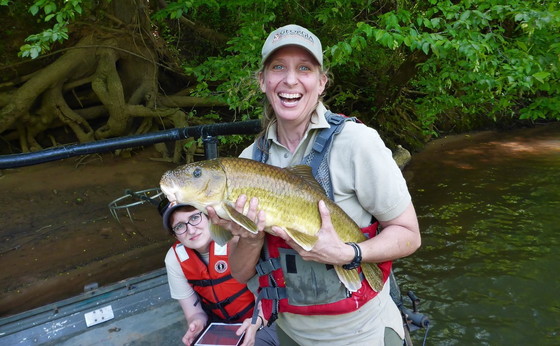 DNR biologist Paula Marcinek with a robust redhorse on the Ocmulgee River (Peter Dimmick/DNR)
By ETHAN HATCHETT
The Ocmulgee River has changed. The cloudy water once ran clear. The sandy bottom was once rocky. Fish swam upriver to breed from places as distant as the Altamaha River, which the Ocmulgee and Oconee rivers join to form near Lumber City, and the Atlantic Ocean.
European settlement changed the river. Centuries of agriculture and development stripped away much of the land’s vegetation that filtered the flow, causing the Ocmulgee to fill with sediment. The soil particles gradually moved through the waterway, covering gravel that fish spawned in, smothering fishes’ eggs, mucking up the water and even building up on the banks, saturating the ground with sediment.
It is impossible to know how many freshwater fish the Ocmulgee lost since the first Europeans arrived. Many species disappeared without being discovered. Yet on a clear afternoon in May, DNR aquatics biologist Paula Marcinek led a team on the upper Ocmulgee in search of robust redhorse, a "lost" fish found in 1991. ...
Read DNR's blog post about efforts to restore the robust redhorse, plus news of a new grant that will expand the work and rare video of these fish spawning.
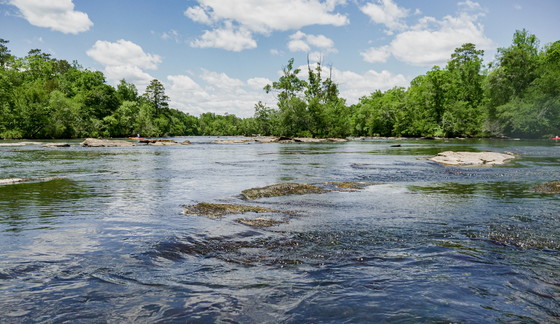 Surveying for robust redhorse on the upper Ocmulgee (Ethan Hatchett/DNR)
WHAT YOU CAN DO
Although the future of the robust redhorse resembles the water it inhabits –troubled, murky and shifting – there is hope. Reducing your sediment runoff at home is a tangible way to help aquatic life in any watershed. Here are some tips:
- Create a rain garden to filter sediment runoff and help stem flooding.
- For “hardscaped” areas in your yard, use permeable materials that allow water to filter through to the soil.
- Cover bare soil with mulch or groundcover.
- Collect excess runoff in a barrel or other receptacle for reuse.
- Add native trees and shrubs to landscapes to reduce erosion.
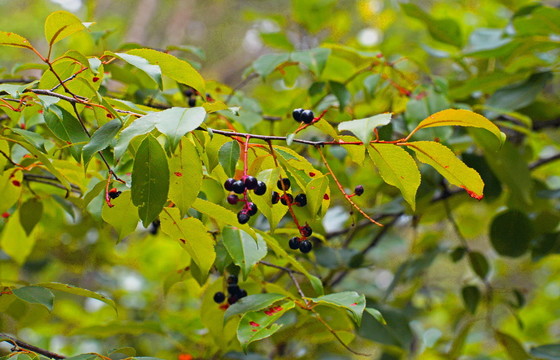 Black cherry fruits (Terry W. Johnson)
By TERRY W. JOHNSON
For the last few weeks, Georgians have been enjoying the first peaches of the year. However, while we have been eating these sweet, fuzzy fruits, birds and other wildlife have been dining on the small but still juicy fruits of black cherry trees.
From late spring through fall, the slender branches of the black cherry often sag under the weight of clusters of round, red-to-almost-black fruits, each of which is only about a third of an inch in diameter.
The berries are eaten by a wide variety of animals, while the tree itself serves as a food source for other animals and a host plant for butterfly and moth caterpillars.
Although considered a “weed” tree by many people, the black cherry is prized by wildlife and has met some unique needs in our nation’s history. …
Read Terry’s column for interesting insights into this native tree.
Terry W. Johnson is a retired DNR program manager and executive director of TERN, friends group of the agency's Wildlife Conservation Section. Check out past columns, his Backyard Wildlife Connection blog and his book “A Journey of Discovery: Monroe County Outdoors.” Permission is required to reprint a column.
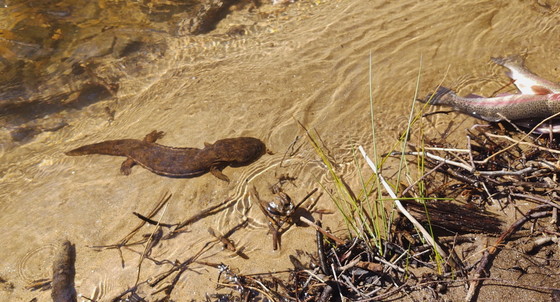 Hellbender angling for trout on a stringer (special to DNR)
Water dog, grampus, snot otter. All of these odd names refer to the same rare amphibian that DNR wildlife biologist Thomas Floyd is keeping tabs on – the eastern hellbender.
In Georgia, hellbenders are found in cold, fast-moving streams at the northernmost edges of the state. The species is North America’s largest salamander. Stretching up to 2 feet long and reaching a hefty 5 pounds, you will know it when you see it.
When you do, whether it’s a big adult or a small juvenile, please do not disturb the hellbender. Instead, take a photograph if possible and email details on the sighting – day, time, place and estimated size of the salamander – to thomas.floyd@dnr.ga.gov.
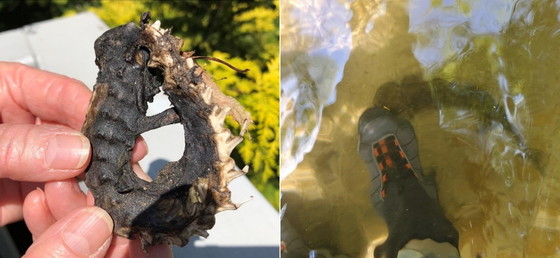 Hellbender remains found beside a stream and a live hellbender in the water (Ethan Hatchett/DNR; special to DNR)
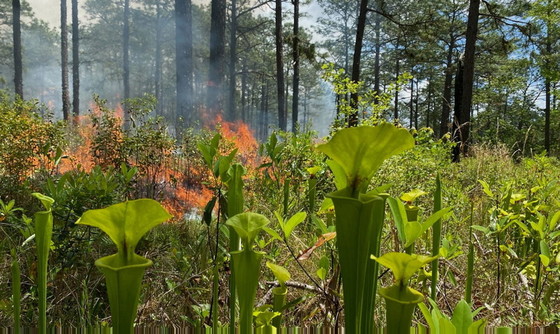 Growing-season burn at Doerun Pitcherplant Bog Wildlife Management Area near Moultrie (Joe Burnam/DNR)
For the second straight year, DNR’s Wildlife Resources Division set a prescribed fire record, topping last year’s 68,422 acres burned with about 74,000 this year. Prescribed fire is critical for restoring and managing fire-adapted habitats and rare species from gopher tortoises to red-cockaded woodpeckers.
Sea turtle nesting in Georgia is on a near-record pace, with the 1,248 loggerhead nests as of June 5 comparing favorably with 1,266 on that date in 2019. Of course, 2019 finished with 3,950 nests, the most since comprehensive surveys began in 1989. As of Thursday, this year’s count exceeded 2,400.
While St. Catherines Island is coping with wildfires, a loggerhead nesting on the island’s south end ran into a different type of trouble when it got stuck in a tidal slough. Georgia Sea Turtle Cooperative workers on St. Catherines and Ossabaw Island teamed up to safely return the big female to the surf.
 Prothonotary warbler (Joe Burnam/DNR)
Along the Alapaha and Ochlockonee rivers in south Georgia, DNR has been banding prothonotary warblers and checking nest boxes in an annual project to monitor the bright yellow migrants, which are in decline because of habitat loss. The leg bands allow staff to track individual birds, such as one male that has returned to Alapaha River bottomlands each spring since 2018.
Recovering America’s Wildlife Act passed the U.S. House last week. With the White House signaling its support, the next step is a Senate vote on the $1.3 billion bill deemed critical for funding state and tribal efforts to conserve more than 1,600 priority species, 640 of which – including prothonotary warblers and Ocmulgee skullcap – are listed in Georgia’s State Wildlife Action Plan.
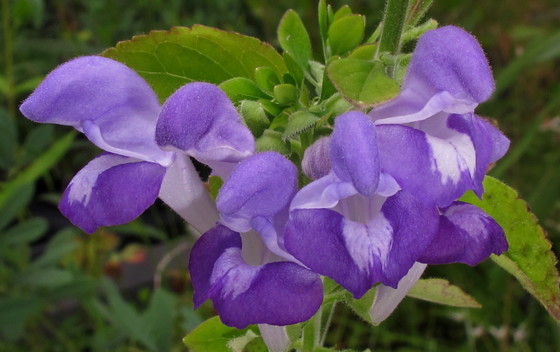 Ocmulgee skullcap (Alan Cressler)
Ocmulgee skullcap is a rare plant found only on bluffs and steep slopes in the Savannah and Ocmulgee River basins. The U.S. Fish and Wildlife Service recently proposed listing Scutellaria ocmulgee as threatened under the Endangered Species Act and designating about 6,600 acres in Georgia and South Carolina as critical habitat. More: "The stealthy search for skullcap."
Just how deadly are entanglements in commercial fishing gear for North Atlantic right whales? A New England Aquarium and Duke University study involving 1,196 entanglements and 573 right whales found that most of the whales that had been severely injured died within three years, and the females that did survive had lower birth rates and longer intervals between calving.
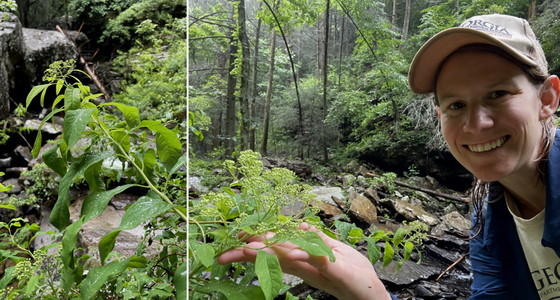 Botanist Stephanie Koontz with Virginia spiraea at Cloudland Canyon State Park (Stephanie Koontz/DNR)
Quick hits:
- DNR botanist Stephanie Koontz re-located Virginia spirea at Cloudland Canyon State Park – one of Georgia's two known sites for the endangered plant – and tagged 25 clumps to sample for a project conserving this and 13 other imperiled species (“Grant grows work to save plants,” July).
- Landowners looking to add a wildflower meadow to their property should read this blog post on the basics by DNR senior wildlife biologist Erin Cork.
- UGA’s Warnell School of Forestry and Natural Resources will hold a free series of land-management workshops geared toward women landowners.
-
Add Idaho to the list of states where the fungus that causes white-nose syndrome, a disease deadly to bats, has been found.
- In other white-nose updates, Mississippi confirmed WNS for the first time and the disease is likely to blame for a 98-percent decline in little brown bats at Azure Cave in Montana, the West's largest known winter colony of the species.
- Reporting turkey poults and hens seen in Georgia from June through August helps DNR gauge state and regional turkey production. Report sightings.
- When camping in bear areas, secure your food, toothpaste, soap and garbage, and don’t cook or store food in or near your tent. More at Bearwise.
- The Florida Fish and Wildlife Conservation Commission offers these wildlife-friendly tips for photographing shorebirds and seabirds.
- Correction: DNR eagle nest survey results will be in the July Georgia Wild.
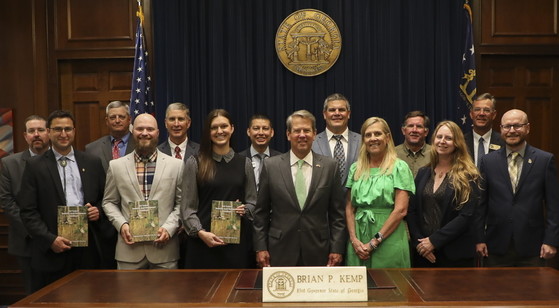 Gov. Brian and First Lady Marty Kemp with DNR leaders and 2022 Forestry for Wildlife partners
Names in the news: Gov. Brian Kemp and DNR leaders recognized corporate forest landowners Georgia Power, Weyerhaeuser and CatchMark Timber Trust as DNR's 2022 Forestry for Wildlife Partners for their wildlife-related stewardship and land management. Matt Elliott, assistant chief of the DNR Wildlife Conservation Section, will co-chair the Gopher Tortoise Council with Rebecca Cozad, a research biologist at Nokuse Plantation in north Florida.
WHAT YOU MISSED ...
In the previous Georgia Wild:
- More tegu sightings
- Terry's favorite oriole
- Go-to site for rare wildlife
- What's new with bird flu
 Whimbrels fly to a roost during a survey of the shorebirds by DNR and Manomet staff. (Emily Jones/WABE-FM)
(+audio) "Whimbrels on the Georgia coast," part of the article "Researchers track nesting whimbrels," WABE-FM (90.1, Atlanta)
"Yellowfin shiners spawning over a bluehead chub gravel nest," DNR (+photos)
"King snake vs. timber rattler," special to DNR
"Conserving Georgia's salt marshes" (with Christi Lambert, The Nature Conservancy) Faces of Resiliency series, UGA Marine Extension and Georgia Sea Grant
Alabama shiner defends nest, courts females, DNR
People, dog rescued from capsized boat on Allatoona, DNR Law Enforcement
"Glasswing butterflies want to make something perfectly clear," Deep Look
"House passes major wildlife conservation bill," Georgia Public Broadcasting
"Some monarch populations rising; is it enough to save them?" The New York Times
"Right whales survival rates plummet after severe injury from fishing gear," Phys.org. Study in Conservation Science and Practice.
Also regarding right whales: "New restrictions on ships to protect whales coming soon" (Associated Press). "Study says climate change affecting whales' use of Cape Cod Bay" (Capecod.com; study in Global Change Biology). "Right whale numbers may be stabilizing but future remains uncertain" (Maine Public). "Endangered whales featured in Canada Post stamp series" (Canada TV).
(+audio) "Wildfire threatens island rich in history," Georgia Public Broadcasting
"An unbreakable will" (profile of DNR's Chip Madren), Newton Community Magazine
"Bald eagle family awaits eaglet’s first flight," Pike County Journal-Reporter
"Best birding hotspots in Georgia," Atlanta Journal-Constitution
"How to help wildlife during a drought," WSAV-TV (Ch. 3, Savannah)
"DNR: Clean feeders save birds," AllonGeorgia
"What to do when you see a snake," Thomasville Times-Enterprise
"Florida wildlife officials say some manatee food growing," Associated Press
"DNR announces Give Wildlife a Chance poster winners," The Albany Herald
"Native plants deserve space in local yards," Monroe County Reporter
"How and why of sharing Georgia beaches with nesting birds," Yahoo!News
(+video) "Police warning follows reports of Tybee beachgoers disturbing sea turtles, nests," WJCL-TV (Ch. 22, Savannah)
"DNR hybrid birdathon for youth draws a crowd," Yahoo!News
"Agency ruling delivers big setback to Okefenokee mining plan," Associated Press
"Kemp, DNR leaders honor Forestry for Wildlife partners," Georgia Outdoor News
"Hunting pythons in Florida? Pro offers tips," NPR. Related: "Biologists catch record-breaking 215-pound python in Everglades," USA Today.
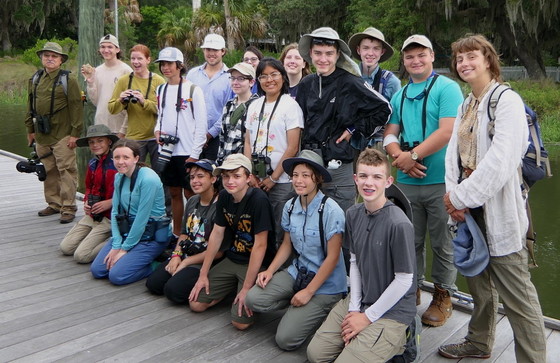 TALON crew; right, Brendan Dunkle and a painted bunting Stacia Hendricks/Little St. Simons; Linda May/DNR)
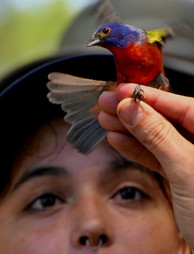
From painted buntings to red knots, 15 teens from six states took a deep dive into ornithology and ecology on the Georgia coast this month via Camp TALON. The annual summer camp features field trips and classes led by experts and visits bird-rich sites such as Little St. Simons Island and Harris Neck National Wildlife Refuge. TALON – Teen Adventures Learning about Ornithology and Nature – goes beyond birding to explore research, wildlife management practices and how participants can contribute to conservation. The camp is made possible by support from TERN (friends group of DNR’s Wildlife Conservation Section), the Georgia Ornithological Society, Georgia Audubon Society and the staff and managers at Little St. Simons.
Top
|
CREDIT
Georgia Wild masthead: eastern hellbender (Thomas Floyd/DNR)
|